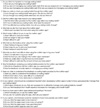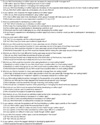Abstract
Objectives
We conducted a qualitative study to explore the feasibility of mobile applications for self-monitoring of diet.
Methods
We conducted in-depth and focus group interviews with eight laymen who had used mobile dietary applications and eight experts. Interviews were audio-recorded and analyzed using an open coding method.
Results
The qualitative data of our study revealed two key themes: (1) perceptions, opinions and attitudes towards mobile applications of self-monitoring of diet and (2) future directions to improve mobile applications.
Conclusions
Our qualitative study suggested the potential use of mobile applications as a food-tracking and dietary monitoring tool and the need for improved mobile applications for self-monitoring of diet. The results of our study may provide insights into how to technically improve mobile applications for self-monitoring of diet, how to utilize dietary data generated through mobile applications, and how to improve individual's health though mobile applications.
Acknowledgments
This research was supported by the MSIT (Ministry of Science and ICT), Korea, under the ITRC(Information Technology Research Center) support program (IITP-2018-2014-1-00720) supervised by the IITP (Institute for Information & communications Technology Promotion).
References
1. Korea Centers for Disease Control and Prevention. Korea Health Statistics 2016 : Korea National Health and Nutrition Examination Survey (KNHANES VII-1). Cheongju: Minister of Korea Centers for Disease Control and Prevention;2017.
2. Korea National Statistical Office. 2016 Cause of death statistics [Internet]. Korea National Statistical Office;2017. updated 2017 Sep 22. cited 2018 Jan 11. Available from: http://kostat.go.kr/portal/korea/kor_nw/2/1/index.board?bmode=read&aSeq=363268.
3. World Health Organization. Noncommunicable diseases [internet]. WHO Western Pacific Region;2013. updated 2017 Oct 29. cited 2018 Feb 05. Available from: http://www.wpro.who.int/noncommunicable_diseases/en/.
4. Alwan A. Global status report on noncommunicable diseases 2010. Geneva: World Health Organization;2011. p. 1–8.
5. Forouzanfar MH, Afshin A, Alexander LT, Anderson HR, Bhutta ZA, Biryukov S, et al. Global, regional, and national comparative risk assessment of 79 behavioural, environmental and occupational, and metabolic risks or clusters of risks, 1990–2015: a systematic analysis for the Global Burden of Disease Study 2015. Lancet. 2016; 388(10053):1659–1724.
6. Willett W. Nutritional epidemiology. New York: Oxford University Press;2012. p. 49–212.
7. Hanyang Cyber University, Ministry of Health and Welfare. The effects of healthcare initiatives using mobile App and wearable devices: A systematic review and focus group interviews. Hanyang Cyber University, Ministry of Health and Welfare;2016. 11. Report No. 11-1352000-001926-01.
8. Schoeppe S, Alley S, Van Lippevelde W, Bray NA, Williams SL, Duncan MJ, et al. Efficacy of interventions that use apps to improve diet, physical activity and sedentary behaviour: a systematic review. Int J Behav Nutr Phys Act. 2016; 13(1):127.

9. Cho JH, Lee HC, Lim DJ, Kwon HS, Yoon KH. Mobile communication using a mobile phone with a glucometer for glucose control in Type 2 patients with diabetes: as effective as an Internet-based glucose monitoring system. J Telemed Telecare. 2009; 15(2):77–82.

10. Kim YS, On JJ, Hong YH, Hong IS, Chang UJ. Effect of food consumption monitoring using a smartphone on weight changes in obese women. J Korean Diet Assoc. 2014; 20(2):123–132.

11. Van Achterberg T, Huisman-de Waal GG, Ketelaar NA, Oostendorp RA, Jacobs JE, Wollersheim HC. How to promote healthy behaviours in patients? An overview of evidence for behaviour change techniques. Health Promot Int. 2011; 26(2):148–162.

12. Kerr DA, Harray AJ, Pollard CM, Dhaliwal SS, Delp EJ, Howat PA, et al. The connecting health and technology study: a 6-month randomized controlled trial to improve nutrition behaviours using a mobile food record and text messaging support in young adults. Int J Behav Nutr Phys Act. 2016; 13(1):52.

13. Robinson E, Higgs S, Daley AJ, Jolly K, Lycett D, Lewis A, et al. Development and feasibility testing of a smart phone based attentive eating intervention. BMC Public Health. 2013; 13(1):639.

14. Zang J, Song J, Wang Z, Yao C, Ma J, Huang C, et al. Acceptability and feasibility of smartphone-assisted 24 h recalls in the Chinese population. Public Health Nutr. 2015; 18(18):3272–3277.

15. Boushey CJ, Harray AJ, Kerr DA, Schap TE, Paterson S, Aflague T, et al. How willing are adolescents to record their dietary intake? The mobile food record. JMIR mHealth uHealth. 2015; 3(2):e47.

16. Froisland DH, Arsand E, Skarderud F. Improving diabetes care for young people with type 1 diabetes through visual learning on mobile phones: mixed-methods study. J Med Internet Res. 2012; 14(4):e111.

17. Kikunaga S, Tin T, Ishibashi G, Wang DH, Kira S. The application of a handheld personal digital assistant with camera and mobile phone card (Wellnavi) to the general population in a dietary survey. J Nutr Sci Vitaminol. 2007; 53(2):109–116.

18. Rollo ME. An innovative approach to the assessment of nutrient intake in adults with type 2 diabetes: the development, trial and evaluation of a mobile phone photo/voice dietary record. Queensland: Queensland University of Technology;2012.
19. Martin CK, Han H, Coulon SM, Allen HR, Champagne CM, Anton SD. A novel method to remotely measure food intake of free-living individuals in real time: the remote food photography method. Br J Nutr. 2009; 101(3):446–456.

20. Rollo ME, Ash S, Lyons-Wall P, Russell A. Trial of a mobile phone method for recording dietary intake in adults with type 2 diabetes: evaluation and implications for future applications. J Telemed Telecare. 2011; 17(6):318–323.

21. Boushey CJ, Spoden M, Delp EJ, Zhu F, Bosch M, Ahmad Z, et al. Reported energy intake accuracy compared to doubly labeled water and usability of the mobile food record among community dwelling adults. Nutrients. 2017; 9(3):E312.

22. Lee CD, Chae J, Schap TE, Kerr DA, Delp EJ, Ebert DS, et al. Comparison of known food weights with image-based portionsize automated estimation and adolescents' self-reported portion size. J Diabetes Sci Technol. 2012; 6(2):428–434.

23. Lee JE, Song S, Ahn JS, Kim Y, Lee JE. Use of a mobile application for self-monitoring dietary intake: Feasibility test and an intervention study. Nutrients. 2017; 9(7):E748.

24. Fuller NR, Fong M, Gerofi J, Ferkh F, Leung C, Leung L, et al. Comparison of an electronic versus traditional food diary for assessing dietary intake: A validation study. Obes Res Clin Pract. 2017; 11(6):647–654.
25. Corbin J, Strauss A. Basics of qualitative research. London: Sage;2008. p. 195–204.
26. Korea Centers for Disease Control & Prevention. Korea Health Statistics 2015: Korea National Health and Nutrition Examination Survey (KNHANES VI-3). Cheongju: Korea Centers for Disease Control and Prevention;2016.
27. Ashman AM, Collins CE, Brown LJ, Rae KM, Rollo ME. Validation of a smartphone image-based dietary assessment method for pregnant women. Nutrients. 2017; 9(1):E73.

28. Kong F, Tan J. DietCam: Automatic dietary assessment with mobile camera phones. Pervasive Mob Comput. 2012; 8(1):147–163.

29. Zhu F, Bosch M, Khanna N, Boushey CJ, Delp EJ. Multilevel segmentation for food classification in dietary assessment. Proc Int Symp Image Signal Process Anal. 2011; 337–342.




 PDF
PDF ePub
ePub Citation
Citation Print
Print







 XML Download
XML Download